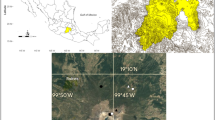Summary
The data introduced here are part of a project lasting from 1976 to 1985 in an acid beech wood forest in the northern part of the Black Forst in Southern Germany. With Enchytraeidae (Oligochaeta) as an example, attempts were made to determine the part played by the mesofauna in the soil system. Parameters such as respiration, production, and consumption were estimated using abundance and biomass data as a basis. The results show that not only the Enchytraeidae but even single species like Cognettia sphagnetorum or Mesenchytraeus glandulosus contribute a measurable amount to the energy flow of the soil ecosystem. The respiration of the whole population, for example, corresponds to 3.4% of the total energy input via leaf litter, and consumption amounts to 8.1% of the total litter including twigs. It seems that the Enchytraeidae contribute around 60% of the total soil animal respiration in this acid beech wood, and thus play an important role in soil renewal.
Similar content being viewed by others
References
Axelsson B, Lohm U, Persson T (1984) Enchytraeids, Lumbricids and soil Arthropods in a northern deciduous woodland: A quantitative study. Holarct Ecol 7:91–103
Babel U, Kreutzer K, Ulrich B, Zezschwitz von H, Zöttl HW (1980) Definitionen zur Humusmorphologie der Waldböden. Z Pflanzenernähr Bodenkd 143:564–568
Beck L (1989) Lebensraum Buchenwaldboden: 1. Bodenfauna und Streuabbau—eine Übersicht. Verh Ges ökol 17:47–54
Beck L, Mittmann H-W (1982) Zur Biologie eines Buchenwaldbodens: 2. Klima, Streuproduktion und Bodenstreu. Carolinea 40:65–90
Beck L, Dumpert K, Franke U, Mittmann H, Römbke J, Schoenborn W (1988) Vergleichende ökologische Untersuchungen in einem Buchenwald nach Einwirkung von Umweltchemikalien. Spezielle Berichte der Kernforschungsanlage Jülich 439:548–701
Brody S (1945) Bioenergetics and growth. Reinhold, New York
Coulson JC, Whittaker JB (1978) The ecology of moorland animals. In: Heal OW, Perkins DF (eds) The ecology of British moors and montane grasslands. Cambridge University Press, London, 27:52–93
Ellenberg H (1982) Vegetation Mitteleuropas mit den Alpen. Verlag Eugen Ulmer, Stuttgart, 989 pp
FAO-Unesco (1974) Map of the World (vol 1), Legend. Unesco, Paris
Makulec G (1983) Enchytraeidae (Oligochaeta) of forest ecoystems: I. Density, biomass and production. Ekol Pol 31:9–56
McBrayer JF, Reichle DE (1971) Trophic structure and feeding rates of forest soil invertebrate populations. Oikos 22:381–388
Mellin A (1988) Untersuchungen zur Autökologie und Funktion von Enchytraeen, Aeolosomatiden und Tubificiden (Oligochaeta, Annelida) im Ökostystem Kalkbuchenwald. Dissertation, Universität Göttingen
Nielsen CO (1961) Respiratory metabolism of some populations of Enchytraeid worms and freeliving Nematodes. Oikos 12:17–34
O'Connor FB (1963) Oxygen consumption and population metabolism of some populations of Enchytraeidae from North Wales. In: Doeksen EJ (ed) Soil organisms. North Holland Publ. Co., Amsterdam, pp 32–48
O'Connor FB (1971) The Enchytraeids. In: Phillipson J (ed) IBP Handbook 18, Methods of study in quantitative soil ecology. Blackwell, Oxford, pp 83–106
Persson T, Lohm U (1977) Energetical significance of the annelids and arthropods in a Swedish grassland soil. Ecol Bull (Stockholm) 23:1–211
Petersen T, Luxton M (1982) A comparative analysis of soil fauna populations and their role in decomposition processes. Oikos 39:287–388
Phillipson J, Abel R, Steel J, Woodell SRJ (1979) Enchytraeid numbers, biomass and respiratory metabolism in a beech woodland, Wytham Woods, Oxford. Oecologia 43:173–193
Reichle D (1971) Energy and nutrient metabolism of soil and litter invertebrates. In: Productivity of forest ecosystems. UNESCO, Paris, pp 465–477
Römbke J (1985) Zur Biologie eines Buchenwaldbodens: 6. Die Regenwürmer. Carolinea 43:93–104
Römbke J (1989) Zur Biologie eines Buchenwaldbodens: 12. Die Enchytraeen. Carolinea 47:55–92
Runge M (1973) Energieumsätze in den Biozönosen terrestrischer Ökosysteme. Scr Geobot 4:1–66
Ryszkowski L (1975) Energy and matter economcy of ecosystems. In: Dobben W, Lowe-McConnel RH (eds) Unifying concepts in ecology. Junk, The Hague, pp 109–126
Singh JS, Gupta SR (1977) Plant decomposition and soil respiration in terrestrial ecosystems. Bot Rev 43:449–528
Standen V (1973) The production and respiration of an Enchytraeid population in blanked bog. J Anim Ecol 42:219–245
Standen V (1980) The production biology of terrestrial Enchytraeidae. In: Brinkhurst RO, Cook DG (eds) Aquatic oligochaete biology. Plenum Press, London New York, pp 211–221
Swift MJ, Heal OW, Anderson JM (1979) Decomposition in terrestrial ecosystems. Studies in ecology, 5, Blackwell, Oxford
Williams NV, Solbe JF, Edwards RW (1969) Aspects of the distribution, life-history and metabolism of the enchytraeid worms Lumbricillus rivalis and Enchytraeus coronatus in a percolating filter. J Appl Ecol 6:171–183
Zachariae G (1964) Welche Bedeutung haben Enchytraeen im Waldboden? In: Jongerius A (ed) Soil micromorphology. Elsevier, Amsterdam, pp 57–68
Author information
Authors and Affiliations
Rights and permissions
About this article
Cite this article
Römbke, J. Estimates of the Enchytraeidae (Oligochaeta, Annelida) contribution to energy flow in the soil system of an acid beech wood forest. Biol Fertil Soils 11, 255–260 (1991). https://doi.org/10.1007/BF00335844
Received:
Issue Date:
DOI: https://doi.org/10.1007/BF00335844




